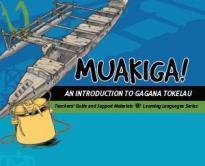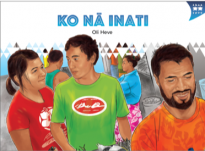You are here:
Overview
These teacher support materials accompany the six storybooks developed especially to support the Learning Languages Series resource Muakiga! An Introduction to Gagana Tokelau. Each story gives students opportunities to extend their language and cultural knowledge and to practise reading the target language of specific units in Muakiga!
These teacher support materials suggest how teachers can use the six storybooks to foster gagana Tokelau learning at levels 1 and 2, particularly in the context of the Muakiga! programme.
The teaching-as-inquiry cycle and the Newton et al. research
[1] on intercultural communicative language teaching underpin these teacher support materials. See:
Schools, ECE centres and education providers can order this storybook from
Down the back of the chair. Enter item number MOE69696 into the search box. For the set of six Muakiga! An Introduction to Gagana Tokelau storybooks, use item number MOE69797.
Muakiga! An Introduction to Gagana Tokelau
Muakiga! is a resource in the Learning Languages Series. It provides a language-teaching programme that can be used by teachers, including those who do not speak gagana Tokelau or know how to teach languages. Muakiga! includes:
- twenty units of three lessons each
- a range of language suitable for years 7–10 at levels 1 and 2 of the curriculum
-
video and audio support to engage learners and demonstrate how fluent speakers
use the language
-
lesson plans that could be linked to opportunities for learners to enjoy reading
gagana Tokelau texts.
You can find Muakiga! online here.
Engaging students with texts
The teacher’s role is to mediate the interactions between the student and the learning materials
and enable the student to meet their learning outcomes.
Ko nā Inati
by Oli Heve
This story supports Unit 12: Fakaputuga o nā Meakai (Gathering Food) in Muakiga!
Schools, ECE centres and education providers can order this storybook from
Down the back of the chair. Use item number MOE69696 in the search box.
Learning goals
Encourage your students to set one or more of the following learning goals for their work with this storybook.
I will use gagana Tokelau to:
- read the story and understand it
- read the story aloud with clear pronunciation and reasonable fluency
- recognise and use some words and expressions in different contexts
- write texts with macrons and correct spelling
- talk or write about the story.
I will use English to:
- understand the story when it is read aloud
- talk about the content of the written and visual texts
- give examples of how Tokelau language and culture are organised in particular ways
- make connections with the language(s) and culture(s) I know
- research and present information about Tokelau culture and values in the story
- make connections with my learning in Unit 12 of Muakiga!
Language and Cultural Knowledge strands
The Language and Cultural Knowledge strands at levels 1 and 2 of Learning Languages in TheNew Zealand Curriculum require students to:
- recognise that the target language and culture are organised in particular ways
- make connections with known languages and cultures.
The language and cultural features of the written and visual texts in the storybook are described here.
(a) Language Knowledge
The language features of the written texts include:
- questions, for example, Ko heā te laulau? / What’s the laualu?; Aiheā lā? / Why is that?
- formulaic expressions, for example, Kai te gali! / That was awesome!; Oka lā! / Phew!; Ōmai ki nā inati! / Come to the inati!
- words specific to agānuku Tokelau, for example, tauvāega, laulau, and inati – these words need to be understood within the context of agānuku Tokelau
- words transliterated from English, for example, pēhini / bowl (basin), paelo / bucket (barrel), and pepa / paper
- markers that define meaning, for example, ki māua / we (she and I – dual); nā inati / the inati, where the use of nā (plural) indicates more than one item for distribution; ki mātou / we (plural – they and I)
- use of different verb forms, for example, havali / walk (singular); hāvavali / walk (plural)
- weather expressions, for example, e toluhefulu fā tīkelī / thirty-four degrees; ko nā aho matagi / cyclone season
- use of tau- as a prefix to indicate persistent, repeated action, for example, kalaga / call, and taukalaga / to call repeatedly and persistently; kikila / look, and taukikila / look repeatedly and persistently
- relationship terms, for example, tei / cousin; tamana / father, dad; uho / brother (of a male or sister of a female); faitamana / uncle; mātua / mother, mum, parents.
(b) Cultural Knowledge
The cultural features of the written and visual texts include:
- reference to Fakaofo as one of the three atolls that constitute Tokelau. The others are Nukunonu and Ātafu. See Unit 1 in Muakiga! for more information about Tokelau.
- a description of the inati process to add to the information in Unit 13 of Muakiga! and pages 8–9 in Gagana Tokelau: The Tokelau Language Guidelines. The laulau can be a concrete platform in the middle of a nuku (village), or just an area of the beach covered with pebbles specially designated for the sharing of inati. In this story, set in Fakaofo, the laulau is under cover. The laulau is the symbol of the communally-owned resource. The food to be shared is laid out in rows, from the biggest to the smallest share.
- reference to the game of tīuga. This game is described on page 130 in Unit 5 of Muakiga!
- references to cooking and cooking practices, for example, the cookhouse is a place set apart for the purpose with a gālafu (open fire).
- specific reference to weather patterns, especially the cyclone season, to indicate a safety concern and the reason for net fishing.
- reference to the men fishing with nets, with illustrations that show the kinds of fish that are typically caught. Some of these fish would be kāmutu (parrot fish), tifitifi (saddle butterfly fish), and pone (red-spotted surgeon).
- roles of people in the village, for example, women cooking; the person calling the people to come to the inati; the tauvāega, whose task it is to share out the communal resources of the village that have been placed on the laulau; and those who have the responsibility to go to the inati to collect their family’s share.
Communication strand
Students learn to apply their language and cultural knowledge in different contexts and situations
to communicate effectively for a range of purposes. As they become more effective communicators, students develop the receptive skills of listening, reading, and viewing and the productive skills
of speaking, writing, and presenting or performing. These are summarised on the
Learning Languages wall chart.
(a) The New Zealand Curriculum
The achievement objectives in learning languages,
levels 1 and 2 are generic.
In selected linguistic and socio-cultural contexts students will:
- receive and produce information
- produce and respond to questions and requests
- show social awareness when interacting with others.
(b) Gagana Tokelau: The Tokelau Language Guidelines
These
guidelines offer achievement objectives that are more specific. You could use any of the following level 2 achievement objectives to narrow the focus for your students to help them achieve particular competencies. In selected linguistic and socio-cultural contexts students will:
- communicate about people, places, and things (2.1)
-
make requests, give instructions, and respond to requests and
instructions (2.8).
(c) Muakiga! An Introduction to Gagana Tokelau
The Unit 12 learning outcomes for students are sharply focused. The following outcomes are relevant to this story. Students will:
- identify food items
- show social awareness when relating to others.
Cross-curricular links
Learners who are working at levels 1 and 2 in gagana Tokelau will be working at higher curriculum levels in other learning areas. Here are three examples of cross-curricular achievement objectives
that could be linked to this story when you are planning links across curriculum learning areas.
Health and Physical Education, Level 3 (Community Resources)
Students will:
-
Participate in communal events and describe how such events enhance the well-being
of the community.
Social Sciences, Level 3
Students will gain knowledge, skills, and experience to:
- understand how people make decisions about access to and use of resources.
Technology, Level 3 (Characteristics of Technology)
Students will:
- understand how society and environments impact on and are influenced by technology in historical and contemporary contexts and that technological knowledge is validated by successful function.
Values
The story illustrates the values of:
- community and participation for the common good
- respect for themselves and others.
See page 10 in
The New Zealand Curriculum.
In addition, students will come to appreciate how the story reflects core Tokelau values of fakaaloalo (respect), māopoopo (inclusion), and vā feāloaki (relating to others). See pages 8–9 in
Gagana Tokelau: The Tokelau Language Guidelines.
[1] Newton, J., Yates, E., Shearn, S., and Nowitzki, W. (2009).
Intercultural Communicative Language Teaching: Implications for Effective Teaching and Learning. Wellington: Ministry of Education.
Back to top ^


